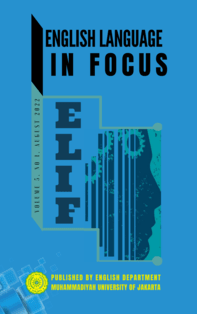Kenn Nesbitt’s Ideas through His Poem “Sleeping Beauty”
DOI:
https://doi.org/10.24853/elif.5.1.19-26Keywords:
children’s poetry, Sleeping Beauty, Kenn Nesbitt, the expressive approachAbstract
The title of this research is Kenn Nesbitt’s Ideas through His Poem “Sleeping Beauty”. The theoretical approach uses the expressive approach by Abrams and the method applied is the qualitative method. The instruments of this research are to observe, collect, and analyze the data with the lines from the poem Sleeping Beauty. The results shows that Nesbitt writes Sleeping Beauty in an imaginable yet humorous way to represent his ideas about what children mostly want to know about a story of a fairy tale. At the end of the lines in the poem, Nesbitt delivers a realistic and funny passage for little children that are in contrast and different from their imaginations.References
About Kenn Nesbitt. – Kenn Nesbitt's Poetry4kids.com. (n.d.). Retrieved April 14, 2022, from https://poetry4kids.com/biographies/about-kenn-nesbitt/
Abrams, M. H. (1953). The Mirror and the Lamp: Romantic Theory and the Critical Tradition. Oxford: Oxford University Press.
Abrams, M. H., & Harpham, G. (2014). A glossary of literary terms. Cengage Learning.
Barron, C. (2013, June 13). Kenn Nesbitt gets a new poet job. The Washington Post. Retrieved April 13, 2022, from https://www.washingtonpost.com/lifestyle/kidspost/kenn-nesbitt-gets-a-new-poet-job/2013/06/13/b06d0628-d36f-11e2-b05f-3ea3f0e7bb5a_story.html
Hornby, A. S., & Turnbull, J. (2010). Oxford advanced learner's dictionary of current English (8th edition.). Oxford: Oxford University Press.
Irmawati, N. D. (2014). Understanding how to Analyze Poetry and its Implication to Language Teaching. Internasional Journal on Studies in English Languange and Literature, 2(1), 35-45.
Khansir, A. A. (2012). Teaching poetry in the ELT classroom. International review of social sciences and humanities, 3(1), 241-245.
Lazar, G. (1993). Literature and Language Teaching: A Guide for Teachers and Trainers (Cambridge Teacher Training and Development). Cambridge: Cambridge University Press.
Lodico, M. G., Spaulding, D. T., & Voegtle, K. H. (2006). Methods in Educational Research: From Theory to Practice. San Fransisco, the United States of America: Jossey-Bass.
Mustakim, S. S., Mustapha, R., & Lebar, O. (2018). Teacher’s approaches in teaching literature: observations of ESL classroom. MOJES: Malaysian Online Journal of Educational Sciences, 2(4), 35-44.
Nesbitt, K. (2009). My Hippo Has the Hiccups: And Other Poems I Totally Made Up. Sourcebooks, Inc.
Ratnawati, R. (2016). USING LITERATURE IN LANGUAGE TEACHING (Penggunaan Sastra dalam Pengajaran Bahasa). SAWERIGADING, 15(3), 380-389.
Published
Issue
Section
License
Authors who publish with this journal agree to the following terms:
- Authors retain copyright and grant the journal right of first publication with the work simultaneously licensed under a Creative Commons Attribution License that allows others to share the work with an acknowledgment of the work's authorship and initial publication in this journal.
- Authors can enter into separate, additional contractual arrangements for the non-exclusive distribution of the journal's published version of the work (e.g., post it to an institutional repository or publish it in a book), with an acknowledgment of its initial publication in this journal.
- Authors are permitted and encouraged to post their work online (e.g., in institutional repositories or on their website) before and during the submission process, as it can lead to productive exchanges, as well as earlier and greater citation of published work (See The Effect of Open Access).


